|
|
 |
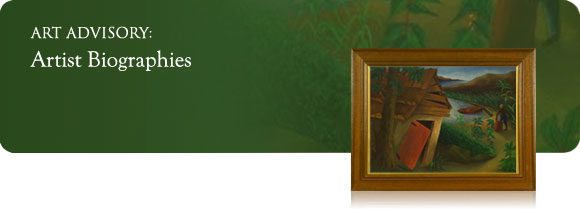
Alphabetical
A | B | C | D | E | F | G | H | I | J | K | L | M | N | O | P | Q | R | S | T | U | V | W | X | Y | Z
Magritte, René
Manet, Édouard
Manning, Ruane
Marchal, Patrice
Marcoussis, Louis
Markus, Csaba
Marsh, Reginald
Martin, Homer Dodge
Mathews, William Thomas
Matisse, Henri
Matta, Roberto
Maurice, Eleanore Ingersoll
Max, Peter
Maybery, Edgar James
McAuliffe, James J.
|
McGann, Val
McKnight, Thomas
Melchers, Gari
Mellor, William
Mêne, Pierre-Jules
Meredith, Maggie
Miró, Joan
Moldovan, Sacha
Morandi, Giorgio
Moses, Will
Moskowitz, Ira
Mossé, Gerard
Munakata, Shiko
Mundy, Charles Warren
|
|
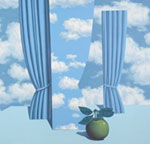
René Magritte
1898-1967
Belgian surrealist artist
René Magritte was born in 1898 in the province of Hainaut, Lessines. He began drawing lessons in 1910. Magritte’s earliest paintings, which date from about 1915, were Impressionistic in style. From 1916-1918 he studied at the Académie Royale des Beaux-Arts in Brussels. The paintings he produced during the years 1918-1924 were influenced by Futurism and figurative Cubism, and many of his works from this period are of female nudes. From 1920-1921, he served in the Belgian infantry. He then worked as a draughtsman in a wallpaper factory and was a poster and advertisement designer until 1926 when he signed a contract with Galerie ‘Le Centaure’ in Brussels, which allowed him to paint full-time. Later in that year he created his first surreal painting, Lost Jockey, and held his first exhibition in 1927. The illusionistic, dream-like quality is characteristic of Magritte’s version of surrealism. His work was not valued much during his lifetime, but interest rose considerably in the 1960s, and his works greatly influenced pop, minimalist, and conceptual art. He died in 1967.
|
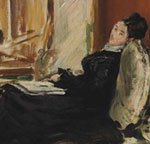
Édouard Manet
1832-1883
French Impressionist painter
Édouard Manet was born in Paris in 1832 to an affluent and well-connected family. His father was a judge who expected him to pursue a career in law. It was his uncle who encouraged him to pursue painting and took him to the Louvre. From 1850-1856, Manet studied under the academic painter Thomas Couture. In his spare time, he copied the old masters in the Louvre. The roughly painted style and photographic lighting in these works was seen as specifically modern, and as a challenge to the Renaissance works that he had copied. He became friends with many Impressionists including Edgar Degas, Calude Monet, Pierre-August Renoir, and Paul Cézanne. He is known for depicting images of leisure and his many café scenes are observations of social life in 19th Century Paris. In 1875 a book-length edition of Edgar Allen Poe’s “The Raven” included lithographs by Manet. He completed his last major work, A Bar at the Folies-Bergere in 1882 and it hung in the Salon that year. He died in 1883.
|
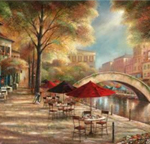
Ruane Manning
20/21st Century
American realist/commercial artist
From a young age, Ruane Manning showed artistic promise. He took art classes at the Philadelphia Museum of Art to learn as much as possible, and as a commercial artist, he won several awards for his illustrations and sculptures from the Philadelphia Art Alliance. After he graduated from art school, he spent several years as an artist in the advertising profession. In 1968, the public fell in love with his printed images of nature, people, and animals. Some of his famous works include Father and Son, which is a portrait of a father black lab and his puppy; Fields of Color, which depicts a rolling countryside with two farm houses, trees, and lush red flowers; Flower Basket with Cats, which shows two kittens in a white basket with pink flowers; and Mediterranean Splendor, which is a charming painting of a coastal village with boats in the small harbor. Over the course of his career, Manning has earned international acclaim for his original masterpieces created for prestigious companies such as the Franklin Mint, the Danbury Mint, and the Hamilton Collection. His sculptures also grace the collections of former U.S. Presidents Ronald Reagan, Gerald Ford, and Jimmy Carter. People enjoy Manning’s paintings so much that many of his images can now be seen on puzzles, plates, calendars, and more. Manning and his family settled down on a farm in southern New Jersey. Today, Ruane Manning is still painting beautiful images of nature in his home studio and art gallery in Lambertville, New Jersey. He continues to paint pictures of animals, plants, Native Americans, sidewalk cafes, and quaint shops.
|
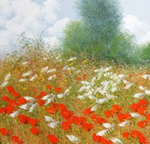
Patrice Marchal
b. 1963
French floral landscape painter
Patrice Marchal was born in 1963 in the Ivory Coast of Africa to French parents. As he grew up, he developed a passion for all of nature, especially wild flowers. When he was older, Marchal moved to the Provence region of France. He is a self taught artist inspired by the French Impressionists, who has been extremely successful, with exhibitions across the globe.
|
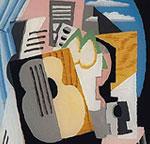
Louis Marcoussis
1878-1941
Polish/French Cubist painter and engraver
Although he was born in Poland, Louis Marcoussis lived in Paris for much of his life and became a French citizen around 1920. He briefly studied law, but then followed his passion and attended the Krakow Academy of Fine arts. The first time a painting of his was exhibited was at the Salon d’Automne in 1905. To earn a living he drew cartoons for satirical journals and took on other drawing and illustration work. Impressionism influenced his early paintings, but from 1911 he was part of the Cubist movement alongside painters like Picasso, Braque, and Juan Gris. In 1925 he had his first solo show in Paris, and his works were shown in exhibitions in both Europe and the United States. In addition to painting still lifes and musical instruments in the Cubist manner, he also produced portraits and views of Paris. From 1930 onward he concentrated on printmaking and illustration, and in the late 1930s, Marcoussis collaborated with Joan Miró and taught him etching techniques. He died in October of 1941.
|
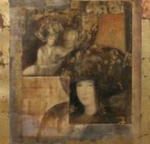
Csaba Markus
b. 1953
Hungarian painter
Csaba Markus was born in Budapest, Hungary in 1953. He spent the first half of his life surrounded by the traditions and Old World ideologies of Europe, and discovered and embraced the artists of the Renaissance. He spent time in museums, studying the works of Michelangelo, Caravaggio, and Botticelli. Markus began to experiment with hundreds of different techniques and media such as glass, sculpture, ceramics, handmade papers, etchings, mono prints, and even animation. The result was a unique style, a contemporary fusion of Renaissance Europe and Classical Mythology. His artistic development was hindered by the rigorous controls of the Communist system in Hungary. Because his style clashed with the beliefs of Communism, Markus realized that he could not flourish in such a restrictive environment and left Europe, eventually settling and opening a studio in California. His works are currently displayed in galleries through the United States, England, France, Russia, and Japan.
|
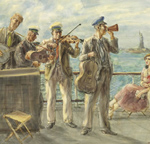
Reginald Marsh
1898-1954
French-born American urban genre painter
Reginald Marsh was born in Paris, France in 1898 to artist parents. In 1900, the family moved to the United States. Marsh studied art at Yale University and the Art Students League, during which time he worked primarily as an illustrator for New York newspapers and magazines. Marsh had his first solo show at the Whitney Studio Club in 1924. He returned to Paris to study art from 1925-1926 and turned seriously to painting. In 1929, he started painting in egg tempera, and continued to paint in this medium extensively for the rest of his life. His lifelong preoccupation was with people – enjoying themselves at the beach, at the amusement park, or on crowded city streets. Marsh is best known as an urban regionalist. He died in 1954.
|
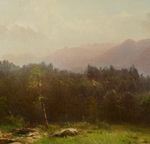
Homer Dodge Martin, N.A.
1836-1897
New York/Minnesota affiliated landscape and portrait painter
Homer Dodge Martin was one of the first artists to introduce Impressionism into American painting. He is known for his melancholy, poetic landscapes, with subtle color and treatment of light. Martin was part of a generation or group of artists whose works were transitional between the Hudson River School and the Barbizon group as it was called in France. This group crossed over from the early Hudson River School, with its attraction to the spectacular vistas of the American landscape, to the Barbizons' rendering of landscape in a more straightforward, anti-classical manner. Returning to the United States, he was of considerable influence on the artist Nicholas Richard Brewer, another proponent of the Barbizon style, who met Martin in the early 1880s. Martin's works often depicted nature's unforgiving and cold characteristics.
Martin was born in 1836 in Albany, New York and as a young man worked as a carpenter and architect. In 1852, he turned to painting, having been encouraged by sculptor Erastus Dow Palmer. Ten years later, he moved to New York City, where he lived for thirty years.
Although he was primarily a self-taught artist, he did study briefly with landscapist James Hart. During his early years as a painter, he faced many hurdles, including his lack of professional training and his physical ailments such as melancholy, chronic eczema, and failing vision that rendered him nearly blind towards the end of his life.
After moving to New York, he began to paint areas in the Upstate New York, including the Hudson River Valley, although it is believed that the Adirondacks provided Martin his favorite venue for sketching. He studied the Hudson River landscapes of John Frederick Kensett and made friends with John La Farge, who was known for his landscape and still life subjects.
Towards the end of his career, in 1893, Martin and his wife moved to Minnesota, having visited there a decade before. He settled in Saint Paul, where he lived while struggling with cancer, failing eyesight, and mental depression and hoped that the clearer air of that city would improve his health. During those years in Saint Paul he was productive, creating works that tended towards abstraction and that have been called some of his finest such as Harp of the Winds: A View on the Seine (1895), (oil on canvas, The Metropolitan Museum of Art in New York City). Other typical works are Sand Dunes at Lake Ontario" and White Mountains, both at Metropolitan Museum of Art, New York, and Sea at Villerville, Kansas City Art Institute.
He became a member of the National Academy of Design in 1874 and in 1877 was one of the founders of the Society of American Artists. Near the end of his life, nearly blind, he painted Adirondack Scenery from memory.
Homer Martin died in St. Paul, Minnesota in 1897.
|
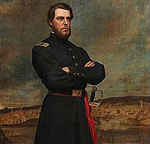
William Thomas Mathews
1821-1905
American, New York and District of Columbia affiliated portrait painter
William Thomas Mathews was born in Bristol, England on
May 7, 1821. His family emigrated to the United States in 1833 and settled in
Navarre, Ohio. William had learned the art of painting miniatures on ivory from
his uncle in England and was eager to travel and study art. When he was
twenty-four, he moved to Cincinnati, where he met Charles Soule. He began an
apprenticeship with Soule and later shared a studio with him. In 1848, Mathews
moved to New York and studied with Charles Loring Elliot. While there, he
exhibited with the National Academy of Design and earned many notable
commissions. Sometimes referred to as the “Painter of Presidents,” Mathews painted
portraits of many prominent Americans, including Abraham Lincoln, William
McKinley, Rutherford B. Hayes, James A. Garfield, Daniel Webster, William
Cullen Bryant, and William Jennings Bryan. In 1855, he opened his studio in
New York City to the public. Near the end of his career, Mathews had a studio
in the Corcoran building in Washington, D.C. Although he was well known, he
spent his later years in poverty and obscurity. Mathews died in Washington
on January 11, 1905.
|
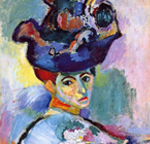
Henri Matisse
1869-1954
French Fauvist painter and draughtsman
Henri Matisse was born December 31, 1869 in Le Cateau, France. At the age of twenty, Henri was working as a law clerk and suffered from appendicitis. It was during his recovery that he began to paint. A little over a year later, Matisse abandoned his work in law and began studying art in Paris. Soon he began to move away from the academic conservative study or art and added more color to his works, reflecting his inspiration from Impressionist works. In 1894, he fathered a daughter, Marguerite, as well as two sons with different women. In the summer of 1905, Matisse worked with Andre Derain. The two began to use bright, clashing colors, causing a sensation. Critics and the public considered their works to be so crude that they became known as Les Fauves, or “the wild beasts.” By 1907, Matisse had moved on from Fauvism and began to focus on studying the human figure. During the early 1930s, he was commissioned to design murals for the Barnes Foundation near Philadelphia, as well as to illustrate a number of books with etchings. As he got older, he suffered from intestinal cancer, which made him unable to sit comfortably at his easel, bringing on another style of art, which involved colored paper and scissors. Matisse’s called his cutouts, “painting with scissors,” and in 1947 he published a book containing prints of his paper collages. In 1951, Matisse completed a monumental four-year project of designing the interior, the glass windows, and the decorations of the Chapelle du Rosaire in Vence. The following year, The Musee Matiss opened in his birth town of Le Cateau-Cambresis, to which he donated 100 of his works. He died in November of 1954.
|
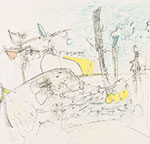
Roberto Matta
1911-2002
Chilean abstract expressionist and surrealist painter
Roberto Matta was born in Santiago, Chile on November 11, 1911. He studied architecture at the Pontificia Universidad Católica de Chile in Santiago. He graduated in 1933 and went to Paris. His travels in Europe and the United States led him to meet artists such as Arshile Gorky, Réne Magritte, Salvador Dalí, André Breton, and Le Corbusier. It was Breton who encouraged Matta and introduced him to the leading members of the Surrealist movement. Matta produced illustrations and articles for Surrealist journals. When he switched from drawing to oil painting in 1938, the first works of his own artistic style began. He often diffused light patterns and bold lines on a featureless background, blending organic and cosmic lifeforms. During the 1940s and 1950s, the disturbing state of world politics was reflected in Matta’s work, with the canvases becoming busy with images of electrical machinery and distressed figures. In the 1960s, Matta added clay to his paintings, adding dimension to his distortions. He died in November of 2002.
|
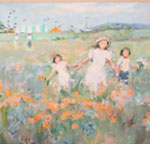
Eleanore Ingersoll Maurice
1901-1995
American still-life and landscape painter
Born in 1901 in New Jersey, Eleanore Maurice represented many different styles of art in her oils, watercolors, pencil drawings, and collages. Her subjects include landscapes, flowers, people, animals, seascapes, and farms. As a child, she studied at the Beard School for Girls in New Jersey and later attended the Art Students League in New York City. In the 1920’s, she worked at Hattie Carnegie’s as a designer and seamstress. In 1934, she married Raymond Maurice and resided in Montclair, NJ, where she began her painting career from home. She and her husband sailed around the world, visiting Africa, Europe, South America, and the Caribbean, from which she got most of her inspiration.
Eleanore juried art shows, performed demonstrations out of her studio for various groups, and gave private lessons in her studio as well. She accumulated over one hundred awards and held numerous memberships. Her work belongs to various museum collections, including the Montclair Art Museum and the Smithsonian Institute. In the 1980’s, her work was represented by the Chime Art Gallery in Summit, NJ. After suffering many strokes, she moved to Arizona with her family in 1992 where she stopped painting. She died in 1995.
|
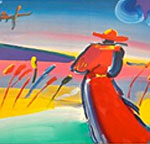
Peter Max
b. 1937
German psychedelic painter and graphic artist
Peter Max was born in Berlin, Germany on October 19, 1937. He spent the first ten years of his life in Shanghai, China. After many travelling experiences to countries such as Tibet, Africa, Israel, and France, he and his family emigrated to America in 1953. Ater high school he continued his art studies at The Art Students League where he learned the rigid disciplines of Realism and developed into a realist painter. After art school, Max became fascinated with commercial illustration and graphic arts both nationally and internationally. He decided to experiment in this style and found himself winning awards for album covers and book jackets. His style is a blend of realism and graphic arts. As the 1960’s progressed, Max developed his signature “Cosmic ‘60s” style, with its own distinctive line work and bold color combinations.
|
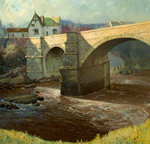
Edgar James Maybery
b. 1887
English painter and etcher
Edgar James Maybery studied art from the age of ten and began
exhibiting his work at the age of sixteen. Maybery completed his artistic
training at the South Kensington School, London. During his career,
Maybery was especially well received for his architectural renderings,
both in oils and in original printmaking. He was elected as a full member
of the Royal Cambrian Society in 1923 and in the following year was elected
to the Royal West of England Academy. Although residing all his life in the
west of England, Edgar Maybery frequently depicted scenes elsewhere,
most notably in London, Oxford, Devon and Cornwall. Public museums in
Manchester, Birmingham and Bristol include his art in their permanent
collections.
|
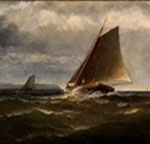
James J. McAuliffe
1848-1921
American equine and marine artist active in Massachusetts
James J. McAuliffe was an American artist known for depicting marine subjects, seascapes, and ships, as well as equine portraits. He studied at the Boston Art School.
|
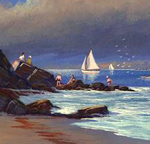
Val McGann
1928-2016
Irish/American painter
Val McGann was born in Ballinasloe County, Galway, Ireland and was an Irish pole vaulting and decathlon champion for many years. He studied at the National College of Art in Dublin and at the Byan Shaw College of Art in London. He has exhibited in Dublin, London, Boston, New York, and Washington, D.C. McGann is a member of the Copley Art Society of Boston and is listed in the Who’s Who of the Irish in America. He had a gallery in Kennebunkport, Maine, but it closed when he passed away recently in 2016.
|
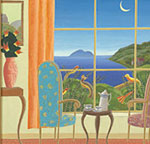
Thomas McKnight
b 1941
American surrealist artist based in New York and Connecticut
Born in 1941 in Lawrence, Kansas, Thomas McKnight grew up in the suburbs of Montreal, New York, and Washington, D.C. After receiving his Bachelor’s Degree from Wesleyan University, he studied art history at Columbia University. He then served in Korea with the army for two years, and later worked for Time Magazine. In 1972, he devoted himself to painting full time, and since then, his work has been exhibited in over four hundred solo shows around the world. His work is represented in the permanent collection of the Metropolitan Museum of Art and the Smithsonian Institute, as well as the New Britain Museum of Art. Seven books of McKnight’s art have been published. His work takes on a surrealist and graphic style with his subjects ranging from landscapes to interior scenes to figures.
|
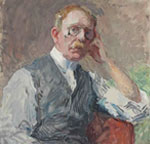
Gari Melchers
1860-1932
American Portrait/Landscape Artist
Gari Melchers was born in 1860 in Detroit, Michigan. Melchers began his artistic training at the Royal Academy of Arts in Dusseldorf when he was seventeen and continued his training at the Académy Julian in Paris. After briefly returning to the United States in 1884, Melchers moved to an artist colony in Egmond, Holland. In 1889 Melchers was awarded the Grand Prix prize at the Paris Salon for “The Communion,” becoming the first American artist, along with the portraitist John Singer Sargent, to receive the award. Besides being a portraitist Melchers also painted landscapes and murals.
In 1893 he received a commission to paint murals for the Chicago World’s Columbian Exposition, and in 1895 he was commissioned to paint the murals for the Library of Congress. Melchers returned to the United States when World War I broke out in Europe. He purchased a piece of property in Falmouth, Virginia naming it The Belmont. The Belmont is now a museum devoted to Melchers life and work and houses the world’s most extensive collection of works by the artist.
|
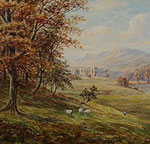
William Mellor
1851-1931
British landscape painter
William Mellor was a Yorkshire landscape painter, who was born in Barnsley. He did not exhibit in London, but his works frequently appear on the market. He worked in Ilkley, Scarborough and Harrogate.
Mellor travelled widely and was inspired by the landscape of North Wales and the North East, particularly Yorkshire. His landscapes are easily recognised; and are generally scenes in summer or early autumn. Travelling in winter was not a pleasant undertaking even in the 19th Century.
With England offering up some of the most poetic and beautiful landscape in the world, we have a lot to thank the 19th Century landscape artists for. Mellor’s concept was aided by rich pickings, from the calm waters and undulating landscape of the English countryside to the rugged and strong scenery of North Wales. With strength of composition and patient observation Mellor painted enchanting records of Britain’s timeless landscape.
The most distinctive feature of Mellor’s paintings is the meticulously delicate rendering of trees and foliage heightened by the rich English sunlight that bathe the scene. Mellor was one of a few who knew so well how to reproduce the peaceful side of nature in its bountiful beauty.
|
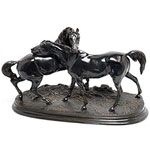
Pierre-Jules Mêne
1810-1877
19th century French sculptor
Pierre-Jules Mêne was born in Paris, France on March 25, 1810. He was the most successful and prolific Animal sculptor of his time. Though he did receive minimal instruction in art, he never attended any of the prestigious art schools and was for the most part a self-taught artist.
|
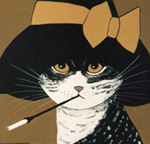
Maggie Meredith
1922-2012
19th century French sculptor
Maggie Meredith was born Helen Elizabeth Pousette-Dart in February of 1922 in Valhalla, NY. After working in many fields that were unsatisfactory, she landed a job at a commercial photographer’s studio in New York City as a photo stylist. She met her husband, Stan Meredith, who had flown engine planes during the war. He bought one of his own and they shortly moved to a house on Nantucket. It was here that her personal art became public. Maggie had her first show at the Little Gallery on the advice of the gallery owner. Since then she has been represented by George Vigouroux’s Gallery, Main Street Gallery, and Sailors Valentine Gallery, until finally she decided that she wanted to have her own studio in her home. Her style evolved into a primitive-contemporary style. She loved painting cats, whales, buildings, and streetscapes, but she is most known for her cats.
|
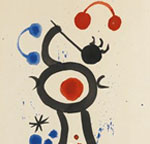
Joan Miró
1893-1983
Spanish abstract painter, sculptor, and ceramicist
Joan Miró was born in Barcelona, Spain on April 20, 1893. He began drawing lessons at the age of seven at a private school in a medieval mansion. In 1907, he enrolled at the fine art academy at La Llotja. He studied at the Cercle Artístic de Sant Lluc and had his first solo exhibition in 1918 at the Dalmau Gallery where his work was ridiculed and defaced. His early works were inspired by Vincent van Gogh and Paul Cézanne. He was inspired by the Cubist and Surrealist exhibitions abroad and decided to move to Paris in 1920, and in 1924 he joined the Surrealist group. The already symbolic and poetic nature of Miró’s work fit well within the context of dream-like automatism, and it began to lose the cluttered chaotic lack of focus that had defined his work thus far. Between 1940-1941, he created twenty-three gouache series, Constellations, revolving around celestial symbolism. Features of this work revealed a shifting focus to the subjects of women, birds, and he moon, which would dominate his iconography for much of his career.
In the late 1940s, Miró lived in Barcelona and frequently visited Paris to work on printing techniques at the Mourlot Studios and the Atelier Lacouriére. He developed a close friendship with Fernand Mourlot and that resulted in the production of over one thousand different lithographic editions. In 1959, André Breton asked him to represent Spain in The Homage to Surrealism exhibition. Miró created a series of sculptures and ceramics, which were completed in 1964. In 1974, he created a tapestry for the World Trade Center in New York, and created another in 1977 for the National Gallery in Washington. He died in December of 1983.
|
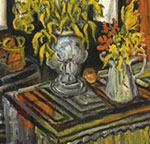
Sacha Moldovan
1901-1982
Russian and New York affiliated still life and landscape painter
Sacha Moldovan was born into a Jewish family on November 4, 1901 in Kishinev, the capital city of the Republic of Moldavia in Southern Russia. He was named Aloysha by his father and nicknamed "Sacha."
From 1902-1913, Moldovan spent his childhood in Czarist Russia. His mother gave him his first set of paints and encouraged him to draw and paint.
In 1914/1915, Sacha and his family emigrated to the United States and settled in New York City's lower East Side. His name became Anglicized to Sol Winestein and Sacha enrolled in school to learn English, while taking night courses at the Cooper Union School of Art. In the early 1920's, Sacha became a U.S. citizen and legally changed his name to Sacha Moldovan, assuming his mother's maiden name. In 1921, he began to study at the National Academy of Design in New York City. From 1922-1923, Moldovan made several trips to Paris by working as a "ship's boy" on freight steamers. In 1924, Moldovan resumed his studies at the National Academy of Design in New York City and produced his first known painting, Femme Au Verre de Vine (Woman with a Glass of Wine). In 1925, Moldovan moved to Paris for approximately eight years and maintained a studio on Avenue Chatillon. He studied at the Académie Julian and the Académie Chaumiere. It was during this time that Moldovan developed his painting style of strong outlines in thick, intensely colored paint. He studied paintings in the Louvre and traveled around Europe to admire the works of Matisse, Van Gough, and Bonnard.
From 1927-1933, Moldovan exhibited his work in various salons and galleries, including the VIII Salon des Tuilleries, the Société des Artists Indépendants, the Galeries Carmine, and the Galerie de la Renaissance Exhibition, which showed the work of forty-five American Artists working in Paris. Moldovan continued to exhibit his work in many shows in New York, Washington D.C., and Paris and finally retired in Yorktown Heights, New York in 1975. Moldovan died on May 17, 1982.
|
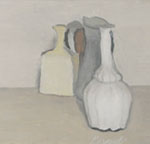
Giorgio Morandi
1890-1964
Italian painter and printmaker, specializing in still life
Giorgio Morandi was born in Bologna, Italy on July 20, 1890. From 1907-1913, he studied at the Accademia di Belle Arti di Bologna. Here, Morandi taught himself to etch by studying books on Rembrandt. He was influenced by many artists, including Picasso, Giotto and Piero Della Francesca. In 1914, he was appointed as a drawing instructor for elementary schools in Bologna, a position he held until 1929. From 1918-1922, Morandi worked in a metaphysical style; thereafter, he focused increasingly on subtle gradations of hue, tone, and objects arranged in a unifying atmospheric haze. From 1930-1956, he was a professor of etching at the Accademia di Belle Arti, and in 1948, the Venice Biennale awarded him first prize for painting. A few years later in 1957, he won he grand prize in São Paulo’s Biennial. He died in June of 1964.
|
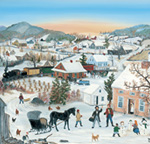
Will Moses
-
20th Century folk artist
Will Moses is the fourth generation of the Moses family beginning with Grandma Moses. Born and raised in Eagle Bridge, NY, Will began painting early and developed his own style of folk art the family is well known for. Will has had several acclaimed exhibitions of his work in the United States, Canada and Japan. The Japanese are his most enthusiastic collectors. Will also illustrates children’s books and has published ten books to date.
|
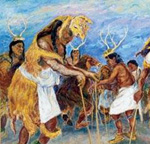
Ira Moskowitz
1912-2001
Jewish American 20th century artist
Ira Moskowitz was born in Galicia, Poland, immigrating to New York in 1927. He studied at the Art Student’s League from 1928-1931. He also studied in Paris and Israel, returning in 1938 when he relocated permanently to Santa Fe, NM. While Moskowitz devoted much of his life to Judaic art, he also had a New Mexico period focused mostly on pueblo life.
|

Gerard Mossé
-
20th/21st Century American Modernist
Gerard Mossé was born in Casablanca and spent his childhood in Morocco and Marseilles before moving to Los Angeles when he was sixteen. He began his artistic career as a painter, but soon incorporated other media into his works. He apprenticed with Michael Frimkess, a well known ceramicist before he moved onto studying sculpture, painting, and drawing at the Otis Art Institute in Los Angeles. Mossé earned his MFA in painting from the Claremont Graduate School of Art in CA, where he also taught courses on contemporary art. He moved to New York in 1987, where his current studio still remains. His work has since shifted from figurative to abstract, as he explores the freeness of line, form, color, and space. Mossé’s methods are painstaking; he spends years making each work, wiping away pigment and building it up again in thin washes to create a luminous, textured quality that is truly unique. “Mossé’s art works have a dense luminosity, which gives the viewer the sensation of looking at the sun. The forms appear to move and bend, giving them a life-like quality. The glowing light is his signature device in which color and glaze are deployed not merely to define light through subtle contrast of complementary hues, but to represent light with aggressive independence, deceiving the eye into thinking there must be some actual source of illumination encased within the picture” (ArtDaily). His first solo exhibit was in 1991 in NY, and he has been showing regularly since then in both solo shows and group exhibitions around the world.
|
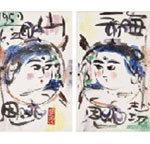
Shiko Munakata
1903-1975
Japanese woodblock artist and painter
A Japanese woodblock printmaker, Munakata was awarded the “Prize of Excellence” at the Second International Print Exhibition in Lugano Switerland in 1952, and was awarded the Order of Culture, the highest honor in the arts, by the Japanese government in 1970. He took many of his themes from the traditions of his native Aomori in northern Japan.
|
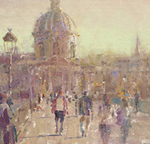
Charles Warren Mundy
b. 1945
American Post Impressionist painter, sculptor
Born in Indianapolis, Charles W. Mundy received his undergraduate degree in art from Ball State University and his Masters of Fine Art at Long Beach State in Los Angeles. Over the years he has received numerous awards from his participation in both regional and national juried exhibits, including the prestigious Hoosier Salon. He was awarded the honor of Signature Membership in Oil Painters of America in 1993. Most recently, his plein air landscapes done in France, Italy, Spain, New England and most recently, Martha’s Vineyard, have received critical acclaim.
|
| |
|
| |
|
|


